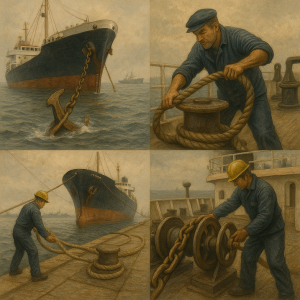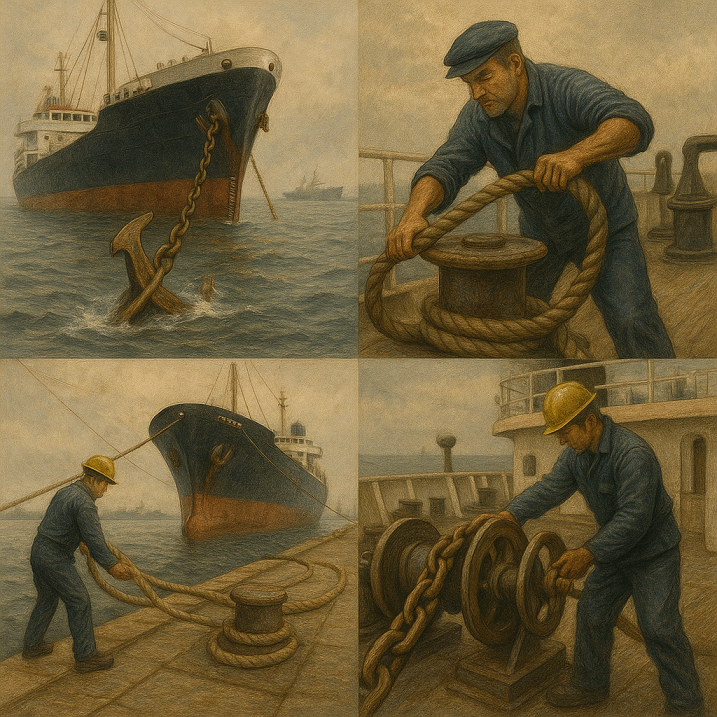Discover how anchoring and mooring procedures ensure ship stability and safety in ports and offshore zones. Learn essential practices, new technologies, and global regulations in this expert maritime guide.

Why Anchoring and Mooring Matter in Modern Maritime Operations
Whether you’re navigating a coastal tanker, a bulk carrier approaching a congested port, or a cruise ship waiting offshore for a berth, anchoring and mooring procedures are foundational to ship safety. At their core, they’re about control—controlling the position of a vessel, minimizing motion, and ensuring safety amid the ever-changing sea conditions.
Incorrect anchoring can lead to groundings, collisions, or even anchor loss—consequences that cost the industry millions annually. According to a study by Lloyd’s List Intelligence (2023), improper anchoring was a contributing factor in over 20% of near-miss incidents in ports. Similarly, mooring failures have resulted in ship breakaways and crew injuries, prompting stronger scrutiny by Port State Control bodies and the IMO.
Yet, this is not just about hardware like windlasses and mooring ropes. It’s a discipline that blends seamanship, meteorology, communication, and regulatory compliance into one complex maritime art.
Understanding Anchoring: Equipment, Principles, and Practice
The Basics of Anchoring
Anchoring is the process of securing a ship in a specific position using an anchor and cable. The equipment typically includes:
- Anchor: The holding device embedded in the seabed
- Chain cable: Connecting the anchor to the ship
- Windlass: The machinery that controls paying out and heaving up the cable
The “scope” (ratio of chain length to water depth) determines the anchor’s holding efficiency. A typical ratio of 5:1 or 7:1 ensures optimal holding.
Types of Anchors and Their Applications
Modern ships use stockless anchors, such as the AC-14 or Hall type, which provide reliable holding power and compact stowage. Specialized vessels—like offshore support vessels—may deploy drag embedment anchors or vertical load anchors for deepwater operations.
The seabed type (mud, sand, gravel, clay, coral) influences anchor selection. For instance, Danforth anchors are ideal in sandy bottoms, while plough anchors suit softer seabeds.
Steps in Anchoring Operations
- Pre-arrival planning: Master and deck officers use ECDIS and anchorage charts to assess depth, seabed, and traffic.
- Approach and let go: Ship reduces speed, aligns into wind/current, and anchor is let go.
- Pay out and snub: Cable is paid out under control. Anchor is “snubbed” (held temporarily) to embed it.
- Monitoring: Bridge team uses radar bearings, GPS, and visual cues to detect dragging.
According to the IMO STCW Code and Bridge Procedures Guide by ICS, regular position checks must be logged every 15–30 minutes while at anchor.
Mooring Techniques: Securing Ships Alongside
What Is Mooring?
Mooring involves fixing a ship to a dock, buoy, or another vessel using ropes, wires, or chains to prevent drift. Mooring lines are often categorized by function:
- Breast lines (limit lateral movement)
- Spring lines (limit fore-and-aft movement)
- Head and stern lines (secure bow and stern)
Common Mooring Arrangements
- Mediterranean mooring (stern-to pier, anchor at bow)
- Alongside mooring (parallel to berth)
- Buoy mooring (at single or multiple buoys)
- Ship-to-ship mooring (STS operations for tankers)
Each arrangement must consider berth structure, tide range, swell, fender types, and environmental forces.
Safety in Mooring
Mooring operations are classified as high-risk. The UK’s MAIB reported in 2022 that 11% of serious crew injuries were mooring-related. Factors include:
- Snap-back zones (danger areas around lines under tension)
- Line handling errors
- Unclear communications
Best practices include:
- Visual markings for snap-back zones
- Proper PPE (helmet, gloves, safety shoes)
- Use of mooring winch brakes and tension monitors
Modern solutions like automated mooring systems (AMS)—already adopted in ports like Helsinki and Rotterdam—reduce reliance on manual handling, increasing safety and reducing berth times.
International Regulations and Guidelines
Anchoring and mooring procedures are guided by multiple regulations:
- SOLAS Chapter II-1: Requires ships to be equipped with anchoring and mooring gear suitable for their operational profile
- IMO MSC.1/Circ.1175: Provides design and operational guidelines for mooring equipment
- STCW Code: Mandates training in anchoring and mooring procedures
- Port State Control (PSC): Inspectors frequently check conditions of winches, windlasses, and wires
Classification societies like Lloyd’s Register, DNV, and ABS also issue design and testing standards, including IACS Unified Requirement A1 for anchor windlasses.
Real-World Applications and Incidents
In 2020, a bulk carrier in Port Hedland, Australia dragged anchor during a strong squall. Investigations revealed insufficient scope and crew unfamiliarity with the local holding ground. The case triggered local port authorities to mandate pre-arrival briefings and seabed-specific anchoring guides.
In another example, the Port of Singapore Authority (PSA) implemented real-time mooring tension sensors and shore-based assistance for high-risk tanker mooring. The move followed a near-miss involving a VLCC whose spring line snapped during berthing.
Such incidents underline the role of human factors, local knowledge, and technology in safe operations.
Challenges and Solutions
Aging Equipment
Older ships often operate with worn-out windlasses and deteriorated anchor chains. PSC detentions are increasingly linked to faulty mooring systems. Regular inspections, maintenance logs, and spare parts inventory (as per ISM Code) are vital.
Climate Change Effects
Rising sea levels and stronger storm surges create unpredictable mooring environments. Floating docks and flexible mooring points are being trialed in low-lying ports like Rotterdam and Manila.
Crew Training and Familiarity
Multinational crews may not have standardized experience. Maritime schools like Massachusetts Maritime Academy and Maritime Knowledge India now emphasize simulator-based training for anchoring and berthing.
New Technology
AI-based systems can now predict optimal anchoring spots using real-time seabed mapping. Mooring load sensors and digital twin simulations (e.g., Wärtsilä’s SmartDock system) allow pre-mooring planning and risk assessment.
Future Outlook
By 2030, anchoring and mooring may become largely automated in key ports. The rise of smart ports under the IAPH initiative is driving the use of shore-based mooring arms, automated fairlead adjusters, and integrated control stations.
IMO’s Maritime Safety Committee is also discussing standards for remote mooring, especially for autonomous ships. While manual skills will still matter, the human role is shifting toward monitoring and decision-making rather than brute handling.
Frequently Asked Questions
What is the difference between anchoring and mooring? Anchoring secures a ship using its anchor and seabed. Mooring uses ropes or chains to secure a ship to a dock, buoy, or another vessel.
How much anchor chain should I let out? A typical scope is 5 to 7 times the depth of water, adjusted for wind, current, and seabed type.
Why do mooring lines snap? Lines can snap due to overloading, wear, poor spooling, or improper material choice. Snap-back injuries are serious risks.
Are anchoring and mooring taught during STCW training? Yes, they are part of operational-level training for deck officers under STCW Table A-II/1 and A-II/2.
What are snap-back zones? These are areas where mooring lines under tension can violently recoil if broken. Crew should avoid these zones during operations.
What is an automated mooring system? An AMS uses mechanical arms, vacuum pads, or magnets to secure a vessel without manual line handling. It is safer and quicker.
Conclusion
Anchoring and mooring are not just checklists in the seamanship manual—they’re dynamic, high-stakes operations where precision, teamwork, and judgment intersect. With global trade rising and port congestion becoming the norm, safe and efficient procedures are more vital than ever.
Technology is transforming how ships anchor and moor, but at its heart, success still depends on training, planning, and respect for the forces of nature.
For maritime professionals, students, or anyone fascinated by ship operations, mastering anchoring and mooring isn’t optional—it’s essential.
References
- IMO STCW Convention and Code
- ICS Bridge Procedures Guide
- Lloyd’s List Intelligence – Safety Reports
- MAIB Reports
- DNV Mooring Standards
- Wärtsilä SmartDock
- Massachusetts Maritime Academy
- Port of Singapore Authority
- International Association of Ports and Harbors (IAPH)
- British Ports Association
- Marine Insight on Anchoring

